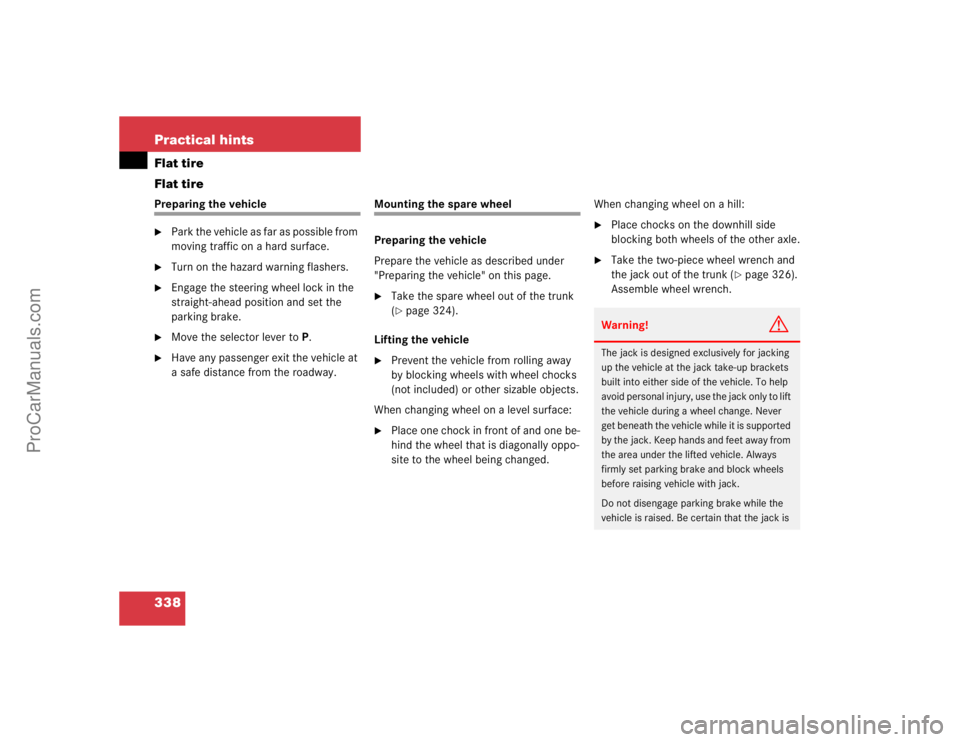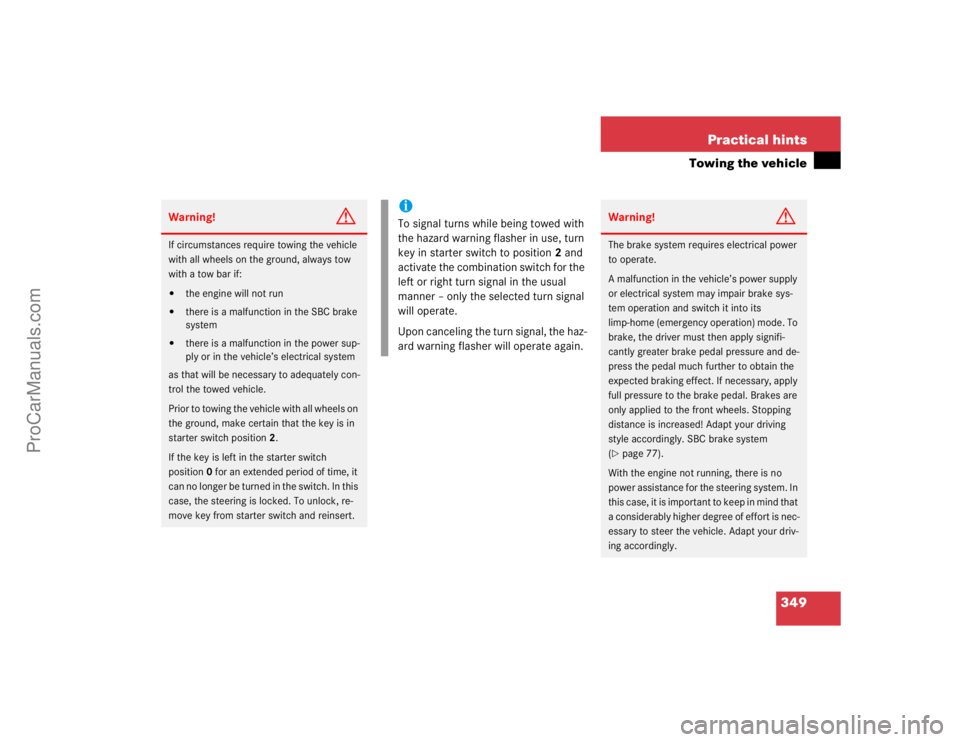Page 318 of 399
318 Practical hintsWhat to do if …Display
Possible cause
Suggested solution
<
Front passenger seat
belt
Please fasten belt!
The display reminds you and your pas-
sengers to fasten seat belts.
�
Fasten the seat belts.
Driver‘s seat belt
Fasten seat belt!
The display reminds you and your pas-
sengers to fasten seat belts.
�
Fasten the seat belts.
_
Steering oil
Visit workshop!
The steering gear oil level is too low.
There is a danger of steering gear dam-
age.
�
Have the system checked by an autho-
rized Mercedes-Benz Center.
Warning!
G
If the level of steering gear oil in reservoir is
too low, the steering power assistance could
fail. Much greater effort will then be needed
to turn the steering wheel.
Do not add steering oil without checking the
steering system.
Do not drive the vehicle. Have the system
checked at your authorized Mercedes-Benz
Center as soon as possible.
ProCarManuals.com
Page 320 of 399
320 Practical hintsWhat to do if …Display
Possible cause
Possible solution
H
Tire pressure monitor-
ing
Visit workshop!
The tire inflation pressure monitor is mal-
functioning.
A wheel without proper sensor was in-
stalled.
�
Have the tire inflation pressure monitor
checked by an authorized
Mercedes-Benz Center.
�
Change the wheel.
Tire pressure, rear left
Caution tire defect!
The left rear tire is rapidly deflating.
�
Carefully bring the vehicle to a halt,
avoiding abrupt steering and braking ma-
neuvers.
�
Change the wheel (
�page 338).
Tire pressure, rear left
Check tires!
The left rear tire pressure is low.
�
Carefully bring the vehicle to a halt.
�
Check the tire pressure.
�
Change the wheel (
�page 338).
Warning!
G
Do not drive with a flat tire. A flat tire affects
the ability to steer or brake the vehicle. You
may lose control of the vehicle.
Continued driving with a flat tire will cause
excessive heat build-up and possibly a fire.
ProCarManuals.com
Page 321 of 399
321 Practical hints
What to do if …
Display
Possible cause
Possible solution
H
Tire pressure, rear
right
Caution tire defect!
The right rear tire is rapidly deflating.
�
Carefully bring the vehicle to a halt,
avoiding abrubt steering and braking ma-
neuvers.
�
Change the wheel (
�page 338).
Tire pressure, rear
right
Check tires!
The right rear tire pressure is low.
�
Carefully bring the vehicle to a halt.
�
Check the tire pressure.
�
Change the wheel (
�page 338).
Tire pressure, front
left
Caution tire defect!
The left front tire is rapidly deflating.
�
Carefully bring the vehicle to a halt,
avoiding abrupt steering and braking ma-
neuvers.
�
Change the wheel (
�page 338).
Warning!
G
Do not drive with a flat tire. A flat tire affects
the ability to steer or brake the vehicle. You
may lose control of the vehicle. Continued
driving with a flat tire will cause excessive
heat build-up and possibly a fire.
ProCarManuals.com
Page 322 of 399
322 Practical hintsWhat to do if …Display
Possible cause
Possible solution
H
Tire pressure, front
left
Check tires!
The right rear tire pressure is low.
�
Carefully bring the vehicle to a halt.
�
Check the tire pressure.
�
Change the wheel (
�page 338).
Tire pressure, front
right
Caution tire defect!
The right front tire is rapidly deflating.
�
Carefully bring the vehicle to a halt,
avoiding abrubt steering and braking ma-
neuvers.
�
Change the wheel (
�page 338).
Tire pressure, front
right
Check tires!
The right front tire pressure is low.
�
Carefully bring the vehicle to a halt.
�
Change the wheel (
�page 338).
Warning!
G
Do not drive with a flat tire. A flat tire affects
the ability to steer or brake the vehicle.
You may lose control of the vehicle. Contin-
ued driving with a flat tire will cause exces-
sive heat build-up and possibly a fire.
ProCarManuals.com
Page 338 of 399

338 Practical hintsFlat tire
Flat tirePreparing the vehicle�
Park the vehicle as far as possible from
moving traffic on a hard surface.
�
Turn on the hazard warning flashers.
�
Engage the steering wheel lock in the
straight-ahead position and set the
parking brake.
�
Move the selector lever toP.
�
Have any passenger exit the vehicle at
a safe distance from the roadway.
Mounting the spare wheel
Preparing the vehicle
Prepare the vehicle as described under
"Preparing the vehicle" on this page.�
Take the spare wheel out of the trunk
(�page 324).
Lifting the vehicle
�
Prevent the vehicle from rolling away
by blocking wheels with wheel chocks
(not included) or other sizable objects.
When changing wheel on a level surface:
�
Place one chock in front of and one be-
hind the wheel that is diagonally oppo-
site to the wheel being changed.When changing wheel on a hill:
�
Place chocks on the downhill side
blocking both wheels of the other axle.
�
Take the two-piece wheel wrench and
the jack out of the trunk (
�page 326).
Assemble wheel wrench.
Warning!
G
The jack is designed exclusively for jacking
up the vehicle at the jack take-up brackets
built into either side of the vehicle. To help
avoid personal injury, use the jack only to lift
the vehicle during a wheel change. Never
get beneath the vehicle while it is supported
by the jack. Keep hands and feet away from
the area under the lifted vehicle. Always
firmly set parking brake and block wheels
before raising vehicle with jack.
Do not disengage parking brake while the
vehicle is raised. Be certain that the jack is
ProCarManuals.com
Page 349 of 399

349 Practical hints
Towing the vehicle
Warning!
G
If circumstances require towing the vehicle
with all wheels on the ground, always tow
with a tow bar if:�
the engine will not run
�
there is a malfunction in the SBC brake
system
�
there is a malfunction in the power sup-
ply or in the vehicle’s electrical system
as that will be necessary to adequately con-
trol the towed vehicle.
Prior to towing the vehicle with all wheels on
the ground, make certain that the key is in
starter switch position2.
If the key is left in the starter switch
position0 for an extended period of time, it
can no longer be turned in the switch. In this
case, the steering is locked. To unlock, re-
move key from starter switch and reinsert.
iTo signal turns while being towed with
the hazard warning flasher in use, turn
key in starter switch to position2 and
activate the combination switch for the
left or right turn signal in the usual
manner – only the selected turn signal
will operate.
Upon canceling the turn signal, the haz-
ard warning flasher will operate again.
Warning!
G
The brake system requires electrical power
to operate.
A malfunction in the vehicle’s power supply
or electrical system may impair brake sys-
tem operation and switch it into its
limp-home (emergency operation) mode. To
brake, the driver must then apply signifi-
cantly greater brake pedal pressure and de-
press the pedal much further to obtain the
expected braking effect. If necessary, apply
full pressure to the brake pedal. Brakes are
only applied to the front wheels. Stopping
distance is increased! Adapt your driving
style accordingly. SBC brake system
(�page 77).
With the engine not running, there is no
power assistance for the steering system. In
this case, it is important to keep in mind that
a considerably higher degree of effort is nec-
essary to steer the vehicle. Adapt your driv-
ing accordingly.
ProCarManuals.com
Page 366 of 399

366 Technical dataFuels, coolants, lubricants etc.
Fuels, coolants, lubricants etc.CapacitiesVehicle components and their respective
lubricants must match. Therefore use only
brands tested and recommended by us.Please refer to the Factory Approved Ser-
vice Products Pamphlet, or inquire at your
authorized Mercedes-Benz Center.
Model
Capacity
Fuels, coolants, lubricants etc.
Engine with oil filter
E320
E500
8.5 US qt (8.0 l)
8.0 US qt (7.5 l)
Recommended engine oils
Automatic transmission
8.0 US qt (7.5 l)
MB Automatic Transmission Oil
1
1MB part no. 001 989 21 03 10Rear axle
E320
E500
1.06 US qt (1 l)
1.37 US qt (1.3 l)
Hypoid gear oil SAE 85 W 90
Power steering
approx. 1.1 US qt (1.0 l)
MB Power Steering Fluid (Pentosin
CHF 11S)
Front wheel hubs
approx. 3.0 oz (85 g) each
High temperature roller bearing grease
Brake system
0.64 US qt (0.6 l)
MB Brake Fluid (DOT 4+)
Cooling system
E320
E500
approx. 10.7 US qt (10 l)
approx. 11.9 US qt (11.3 l)
MB 325.0 Anticorrosion / Antifreeze
Fuel tank including a reserve of
21.12 US gal (80.0 l)
2.38 US gal (9.0 l)
Premium unleaded gasoline:
Posted Octane 91 (Avg. of 96
RON / 86 MON)
Air conditioner system
R-134a refrigerant and special PAG lu-
bricant oil (never R-12)
ProCarManuals.com
Page 376 of 399

376 Technical termsControl system
The control system is used to call up
vehicle information and to change
component settings. Information and
messages appear in the multifunction
display. The driver uses the buttons on
the multifunction steering wheel to
navigate through the system and to ad-
just settings.
Cruise control
Driving convenience system for auto-
matically maintaining the vehicle speed
set by the driver.Distronic*
A driving convenience cruise control
system which helps the driver maintain
a pre-selected speed:
�
If there is no vehicle directly ahead,
the system operates in the same
way as conventional ->cruise con-
trol.
�
If a slower moving vehicle is ahead,
Distronic will reduce your vehicle
speed to the extent permitted by re-
duced throttle and up to 20% brak-
ing power to maintain the preset
minimum following distance.
DTR
(->Distronic*)Engine number
The number set by the manufacturer
and placed on the cylinder block to
uniquely identify each engine pro-
duced.
Engine oil viscosity
Measurement for the inner friction (vis-
cosity) of the oil at different tempera-
tures. The higher the temperature an
oil can tolerate without becoming thin,
or the lower the temperature it can tol-
erate without becoming viscous, the
better the viscosity.
ESP
(E
lectronic S
tability Pr
ogram)
Improves vehicle handling and direc-
tional stability.
ProCarManuals.com